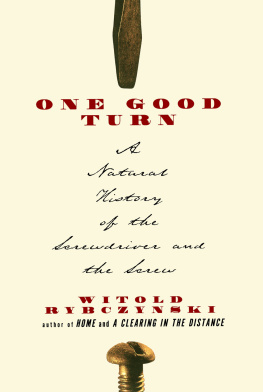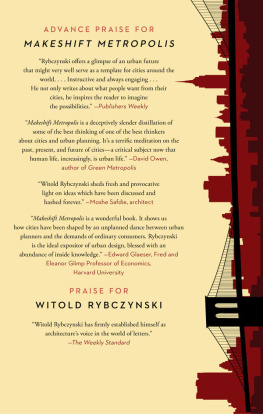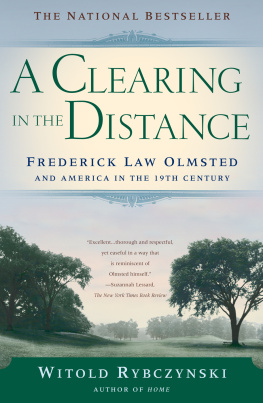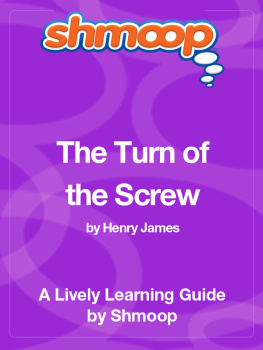Rybczynski - One Good Turn: A Natural History of the Screwdriver and the Screw
Here you can read online Rybczynski - One Good Turn: A Natural History of the Screwdriver and the Screw full text of the book (entire story) in english for free. Download pdf and epub, get meaning, cover and reviews about this ebook. City: New York, year: 2013;2000, publisher: Scribner, genre: Non-fiction. Description of the work, (preface) as well as reviews are available. Best literature library LitArk.com created for fans of good reading and offers a wide selection of genres:
Romance novel
Science fiction
Adventure
Detective
Science
History
Home and family
Prose
Art
Politics
Computer
Non-fiction
Religion
Business
Children
Humor
Choose a favorite category and find really read worthwhile books. Enjoy immersion in the world of imagination, feel the emotions of the characters or learn something new for yourself, make an fascinating discovery.
- Book:One Good Turn: A Natural History of the Screwdriver and the Screw
- Author:
- Publisher:Scribner
- Genre:
- Year:2013;2000
- City:New York
- Rating:3 / 5
- Favourites:Add to favourites
- Your mark:
- 60
- 1
- 2
- 3
- 4
- 5
One Good Turn: A Natural History of the Screwdriver and the Screw: summary, description and annotation
We offer to read an annotation, description, summary or preface (depends on what the author of the book "One Good Turn: A Natural History of the Screwdriver and the Screw" wrote himself). If you haven't found the necessary information about the book — write in the comments, we will try to find it.
One Good Turn: A Natural History of the Screwdriver and the Screw — read online for free the complete book (whole text) full work
Below is the text of the book, divided by pages. System saving the place of the last page read, allows you to conveniently read the book "One Good Turn: A Natural History of the Screwdriver and the Screw" online for free, without having to search again every time where you left off. Put a bookmark, and you can go to the page where you finished reading at any time.
Font size:
Interval:
Bookmark:
Thank you for downloading this Scribner eBook.
Join our mailing list and get updates on new releases, deals, bonus content and other great books from Scribner and Simon & Schuster.
C LICK H ERE T O S IGN U P
or visit us online to sign up at
eBookNews.SimonandSchuster.com

to Shirley
Heurka! [Ive found it!]
A RCHIMEDES
T HIS ALL STARTS with a telephone call from David Shipley, an editor at the New York Times. Would I write an article for a special millennium issue of the Sunday magazine? he asks. The end of the millennium is on many magazine editors minds, and I have had a number of such requests. Shipley explains that the theme of the issue is The Best of the Millennium. That sounds interesting. What do you want me to write about? I ask.
Were hoping that you can write a short essay about the best tool, he answers.
I am a bit let down. The best tool is hardly as weighty a subject as the best architect or the best city, topics I could really sink my teeth into. Still, I have been working on a long biography and would welcome a break. Writing about the best tool of the millennium might even be fun.
While David Shipley is speaking, I compose the essay in my head. There is so much to choose from: paper clips, fountain pens, eyeglasses. I have recently Medieval eyeglasses were only for farsighted people and were used for reading and writing. They were the first practical application of the new science of optics, paving the way for such far-reaching inventions as the telescope and the microscope. A key influence on literacy, astronomy, and biology, eyeglasses surely qualify as the best tool of the millennium. This is going to be easy.
However, when I mention my idea to David, it becomes clear that he has something else in mind. He means tool in the literal sensea handsaw or a hammer. So, not eyeglasses. He must hear the disappointment in my voice, and he points out that I once wrote a book about building my own house. That might make a good starting point, he suggests helpfully. All right, I say, Ill think about it.
In my case, building my own house meant actually building it. My wife and I, with the occasional help of friends, mixed concrete, sawed wood, plastered walls, and installed plumbing. We did everything ourselves except the electrical wiring. Ever since my boyhood experiences with recalcitrant train sets, I have been thwarted by electricity. Despite my fathers patient explanationshe was an electrical engineerand a college physics course, I never grasped the relationship between voltage, current, and resistance. Electricity, in fact, was a problem in our house-building projectthere was none. We were building on a rural site about eight hundred feet from the road, and although we planned to bring in power, initially we could not afford the cost of a temporary line. Renting a gas-powered generator would be expensive, tooand noisy. I decided to build the framing and exterior of the house by hand. Once the basic structure was finished, which promised to take a year or two, we would bring in a line and hire a professional to install the electrical wiring.
Does one of my carpenters tools qualify as the millenniums best? I discount power tools. I had used a portable circular saw, a drill, and a sander for finishing and cabinetwork, but these are chiefly laborsaving devices. Not that productivity isnt important. Ken Kern, the author of The Owner-Built Home, estimates that cutting all the two-by-fours for the frame of a small house would take seven full days using a handsaw, and only thirty minutes using a power saw.cutting wood with power tools, but the result, while more quickly arrived at, is no different than if I use a handsaw. In any case, I enjoy working with my hands. One of the rewards of building something yourselfa house or a bookshelfis the pleasure of using tools. Hand tools are true extensions of the human body, for they have evolved over centuries of trial and error. Power tools are more convenient, of course, but they lack precisely that sense of refinement. No doubt, if I spent my life hammering nails, I would feel differently about the virtues of a nail gun, say. Yet increasing the productivity of carpenters does not seem to me in the same category as the invention of entirely new devices such as eyeglasses.
That leaves my box of hand tools. The tools required for the construction of a small wood-frame house fall roughly into four categories: measurement, cutting and shaping, hammering, and drilling. My measuring tools include a try square, a bevel, a chalk line, a plumb bob, a spirit level, and a tape measure. A little reading informs me that almost all these tools predate our millennium; indeed, most predate the first millennium of the Christian age. A Roman builder, or mensor aedificorum, was familiar with the try square, the plumb line, and the chalk lineall tools that were developed by the ancient Egyptians.with a plumb bob suspended from the apex. To level, the string was lined up with a mark in the center of the crossbar. Not as compact as my spirit level, perhaps, but obviously just as serviceable since A-levels continued to be used until the mid- 1800 s. The spirit level, with its sealed tube containing an air bubble floating in alcohol, was invented in the mid- 1600 s. It was first exclusively a surveying instrumentit took another two hundred years to find its way into the carpenters toolbox. For measuring length, the Roman mensor used a regula, or a wooden stick divided into feet, palms, twelfths or unciae (whence our inches), and digiti or finger widths. I have a yardstick, too, but most of my measuring is done with a retractable steel tape. That, at least, would impress my Roman counterpart, whose only compact measuring device was a one-foot bronze folding rule. Oak yardsticks were used in the Middle Ages, and folding rules, in ivory, brass, or boxwood, reappeared in the eighteenth century. I cant find the origins of the tape measure, but I would guess that it was developed sometime in the late 1800 s. I would be lost without my twenty-five-foot retractable tape measure, but it does not seem to me to qualify as the best tool of the millennium.
I own several saws. The handsaw, too, is an ancient tool: archaeologists have found metal-toothed Egyptian saws dating back to 1500 B.C. They have broad blades, some as long as twenty inches, curved wooden handles, The Romans made two important improvements. They used iron for the blades, which made them stiffer, and they set the teeth of the saw to project alternatively right and left, which had the effect of making the saw-cutor kerfslightly wider than the blade, allowing smooth movement.
The Romans also invented the stiffened backsaw, whose blade is reinforced at the top. This prevents straight-through cuts, but the tool is useful for cabinetwork, especially when used in combination with a miter box. The most ingenious Roman addition to cutting tools is the frame saw. A relatively inexpensive narrow blade is held in a wooden frame and is kept taut by tightening a cord. Wooden frame saws worked so well that they remained the most common type of saw well into the nineteenth century (the principle of the frame saw survives in the modern hacksaw). In the midseventeenth century, a new type of saw was introduced in Holland and England. It had a broad, unstayed blade and a wooden pistol-grip handle. The rigid blade, originally made by rolling steel strips, makes a more accurate cut than a frame saw, and there is no frame to interfere with deep cuts. This effective tool became the basic modern handsaw. My workhorse is a twenty-six-inch Disston crosscut handsaw, with a skew-back blade, first introduced in 1874 by Henry Disston, a Philadelphia saw-maker. The open handsaw is a definite contender for best tool, but while it is certainly an elegant solution to an old problem, I think that David expects something a little more momentous.
Next pageFont size:
Interval:
Bookmark:
Similar books «One Good Turn: A Natural History of the Screwdriver and the Screw»
Look at similar books to One Good Turn: A Natural History of the Screwdriver and the Screw. We have selected literature similar in name and meaning in the hope of providing readers with more options to find new, interesting, not yet read works.
Discussion, reviews of the book One Good Turn: A Natural History of the Screwdriver and the Screw and just readers' own opinions. Leave your comments, write what you think about the work, its meaning or the main characters. Specify what exactly you liked and what you didn't like, and why you think so.








